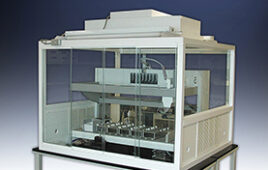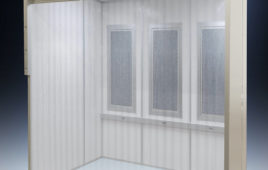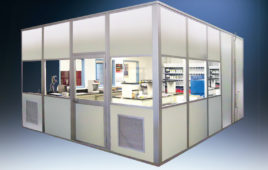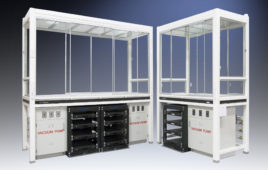The boss materializes in your doorway and announces: “Our best customer is complaining about contaminated product. Go pick out a new cleaning machine.” Your goal is not just to purchase a new cleaning system. Your goal is to achieve critical cleaning.
Look before you buy
Clarify the problem. Have the standards of cleanliness changed? Is the controlled environment no longer appropriate to the application? Perhaps the process is being run incorrectly; if so, employee education or training may be needed. The cleaning chemistry may have been reformulated; there may be a maintenance problem with simple and inexpensive solutions.1 If the current cleaning equipment cannot be brought up to standards, perhaps a new version of your cleaning system is in order. However, you may not want to simply purchase a clone of your current cleaning machine.
Critical product cleaning requires planning and evaluation. This involves determining how clean is clean enough for your application. It is possible that the parts or components being assembled have gradually changed over time. There could be a materials compatibility problem. Materials of construction are sometimes specified by physical parameters, not necessarily by chemical attributes. There could be lot to lot variation; there could be a new supplier. Speaking of chemical attributes, the cleaning agent itself may have been modified, perhaps as a result of safety and/or environmental regulatory issues.
If it appears that new cleaning equipment is needed, you have to consider the entire process. Actually testing the process is a must to achieve effective critical cleaning and to avoid product damage. However, testing often requires using one or more applications laboratories. This means working with those who manufacture or distribute cleaning chemistries and cleaning equipment.
Non-productive testing
Some of you may hesitate to work with applications laboratories. You submit samples of the product and soil to the applications lab; you explain what cleaning chemistries and other process parameters you would like tested. Time passes; and eventually, you receive a multi-page report that boils down to something along the lines of: “we tested your subassemblies and the soils you sent in our standard cleaning system using our standard cleaning chemistry with our standard settings; and in our opinion it worked really well, so purchase our cleaning system.” Such reports do not provide useful information. What follows are some basic steps to preparing to use applications labs productively and with clarity.
Initial evaluation
Begin by opening your mind to the range to possibilities in critical cleaning, including aqueous, solvent, and so-called “non-chemical” approaches. Perform initial vetting of cleaning chemistries and processes.
Review potential safety, environmental, and company policy issues. Determine if company policy and/or the safety and environmental professionals have major headaches with processes under consideration. If there are problems with an approach that looks to be the most viable approach in terms to surface quality and contamination control, don’t give up. Review the issues with those having the objections; it may be possible to use personal protection, or, even better, to incorporate engineering controls.
Review the facility’s logistical and fiscal constraints. Where will the equipment be located? Conducting the cleaning process in a controlled environment is not effective if the process itself contaminates that controlled environment. What costs are involved? One obvious cost is capital equipment. However, you have to consider a number of other costs such as chemicals, other disposables and peripherals, and process time.
Contact promising suppliers directly;2 this includes both the cleaning agents and the cleaning equipment. In some cases, sales representative can provide useful insights. However, for critical applications, we suggest that you introduce yourselves to the technical people. Determine their understanding of your requirements; get details about their applications laboratory.
In-house?
A preliminary in-house evaluation is a valuable prelude to working with the applications lab. At this point, the more promising process candidates, both for the cleaning chemistry and the cleaning equipment, should become apparent. Do a bit of benchtop testing to get a rough estimate of performance. Dipping the component in the cleaning agent of interest often is not informative. It is important to consider the impact of heat, force, and time. However, benchtop testing using stirring bars and small ultrasonic tanks generally does not emulate the production situation. Please coordinate all testing with your safety and environmental professionals, and read the Safety Data Sheets. We occasionally receive inquiries as to how long to clean in heated alcohol or even acetone. The answer is: don’t even think about it!
For a few applications, it may be feasible to lease promising cleaning equipment and perform pilot testing in-house. This avoids the entire issue of the applications laboratory. However, the cleaning equipment has to be coordinated with the cleaning agents under consideration. Changing cleaning agents may require equipment modification; and such modification may not be trivial.
All of which brings us back to working with the applications laboratory. There are ways to make testing at vendor/supplier facilities efficient and productive. We’ll tell you more about that in our next column. In the meantime, follow through on some of our suggestions. Inspect the current dysfunctional equipment. Reach out to potential suppliers. Review company and regulatory constraints. Consider some initial benchtop testing. Most important: begin with the end in mind; determine your actual cleanliness requirements.
References
1. B. Kanegsberg and E. Kanegsberg, “A Stitch in Time-Maintaining Critical Cleaning Equipment,” Controlled Environments Magazine, March 2013.
2. B. Kanegsberg, “Evaluating, Choosing, and Implementing the Process: How to Get Vendors to Work with You,” Handbook for Critical Cleaning, Volume 2: Applications, Processes and Controls, CRC Press (2011).
Barbara Kanegsberg and Ed Kanegsberg (the Cleaning Lady and the Rocket Scientist) are experienced consultants and educators in critical and precision cleaning, surface preparation, and contamination control. Their diverse projects include medical device manufacturing, microelectronics, optics, and aerospace. Contact: [email protected]
This article appeared in the May 2014 issue of Controlled Environments.




